« July 2007 | HOME PAGE | September 2007 »
August 30, 2007
The Kite Runner in Kasghar
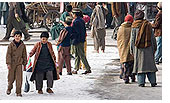 Ever since I missed my chance to portray a "Russian Doctor" (male, 30–50 yrs old, Russian-looking American) during the casting call last year for extras in The Kite Runner, I've been keeping an eye on the film.
Ever since I missed my chance to portray a "Russian Doctor" (male, 30–50 yrs old, Russian-looking American) during the casting call last year for extras in The Kite Runner, I've been keeping an eye on the film.
A good portion of The Kite Runner is set in Afghanistan, which for obvious reasons right now isn't a great place for Hollywood-types to get comfy and cozy. So, being right next door to Afghanistan and featuring nearly identical "brown-skinned people", mud-brick houses, snow-capped peaks, and tiny donkeys, Xinjiang was the obvious choice. (Howard W. French's article on the shooting location is a good read.)
The Afghan scenes were shot in multiple locations between Kashgar and Tashkurgan, including the stunning Pamir Mountains. A preview for the The Kite Runner, which comes out later this year, has finally been posted to YouTube. Can you spot the Xinjiang?
Here's my list of spooky-preview-man dialog matched with possible shooting locations:
"Two friends" (Kashgar); "as close as brothers" (Stone City ruins near Tashkurgan); "war forced them" (donkey crossing a bridge near Kashgar); "apart" (desert road near Kasghar); "forgive me" (Pamir Mountains); "the Taliban took him" (streets of Kasghar); "no longer knows" (stadium where?); "this Fall" (Pamir Mountains); "So what brings you back to Afghanistan?" (streets of Kashgar); "his father meant a lot to me" (streets of Kasghar); "time" (that boy could be running anywhere); "one of the most anticipated films of the year" (ruins near Tashkurgan); "you know what they will do to you" (Karakoram Highway and Kasghar); "I dream that someday" (Kasghar); "and kites will fly" (Kasghar).
Phew! That was fun. I can't wait to do this for an entire two-hour movie instead of a short two-minute preview. Now won't that be a blog entry? (I'm kidding, but seriously... I am really looking forward to this film.)
posted August 30, 2007 at 03:35 PM unofficial Xinjiang time | Comments (70)
August 27, 2007
Przewalski's Good, Bad, and Ugly News.
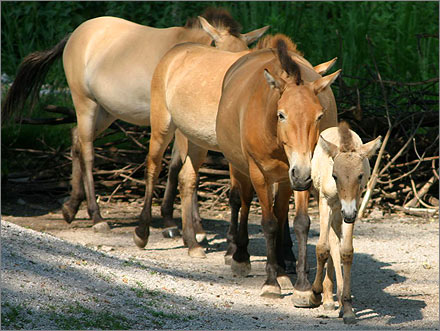
The good news...
Six captive-bred Przewalski's horses, an endangered species, have been released into a nature reserve in northwest China's Xinjiang Uygur Autonomous Region. The six horses, one male and five females, were released onto the plains of Kamusite, part of the Kelameili Nature Reserve, from the Xinjiang Wild Horse Breeding and Research Center. (Xinhua, 07/08/21)
The bad news...
There are only about 2,500 Przewalski's horses in the world. The horses living in the wild in Xinjiang became extinct in the 1960-70s. (Xinhua, 07/08/21)
And the ugly news.
Two rare Przewalski's horses - a mare and a foal - were knocked down and killed by passing cars in separate incidents on an expressway last week, according to a Xinjiang wild-horse breeding-research centre. (SCMP, 07/08/21)
I hope neither of the dead horses was the Przewalski sponsored by the good guys up at the Fubar in Urumqi.
The funny thing is that the stories appeared in separate newspapers on the same day. Coincidence? I think not. I'm imagining some lazy wild-horse researchers having a conversation by the side of the road...
"Shouldn't we drive in a bit further?"
"Nah, just let them out here, by the side of the road. I want to get back home for Part 339 of Rediscovering the Yangtze River on CCTV-9."
"Yeah, that show is awesome. OK, I'll go back and let out the horses."
Neigh! Screeeeech. Splat!
"Uh oh."
Endangered horses released into nature in NW China
21 August 2007
Xinhua News Agency
(c) Copyright 2007 Xinhua News Agency
URUMQI, Aug. 21 (Xinhua) -- Six captive-bred Przewalski's horses, an endangered species, have been released into a nature reserve in northwest China's Xinjiang Uygur Autonomous Region.
The six horses, one male and five females, were released onto the plains of Kamusite, part of the Kelameili Nature Reserve, from the Xinjiang Wild Horse Breeding and Research Center.
The male horse was given to the center by a German zoo in 2005 while the five females were born and bred in the center.
The center released a total of 45 horses in two batches in 2001 and 2004 to the nature reserve.
There are only about 2,500 Przewalski's horses in the world. The horses living in the wild in Xinjiang became extinct in the 1960-70s.
The Xinjiang wild horse center opened in 1986 with the import of 18 horses from the United States, Britain and Germany.
The center keeps 290 horses, most of them in captivity. It started to release the horses into a semi-wild environment in 2001.
posted August 27, 2007 at 11:00 AM unofficial Xinjiang time | Comments (50)
August 23, 2007
Russia's Uyghur Shaolin

I didn't pay much attention to news reports earlier this month that President Putin of Russia and Prince Albert II of Monaco were vacationing on Lake Tere-Khol, along Russia's border with northwestern Mongolia. It turns out that the fortress being excavated on one of the lake's small islands, which I'd only heard described as having "Chinese features", was actually constructed by the Uyghurs during their pre-Islam khanate stretching from Xinjiang to the Pacific Ocean. (Reuters called it a "Uigurian" fortress.)
The site is being excavated and renovated with hopes that it can become a lucrative tourist attraction for a very remote part of Russia populated mostly by ethnic Tuvans. Sergei Shoigu, who is a native Tuvan and holds the fantastic title of Russian Minister for Extraordinary Situations, said:
"We shall build there a Russian Shaolin and invite everybody to come there. And our youth will come I am sure. They will learn philosophy, Tibetan medicine, horseracing, and oriental martial arts in there."
If you build it, I will come. Keep up with developments at Tuva-Online.
posted August 23, 2007 at 10:45 AM unofficial Xinjiang time | Comments (60)
August 20, 2007
"Peace Mission 2007" Caption Contest

Some of you ― or perhaps just one of you, I'm not quite sure ― have been on my case for months now to do another caption contest. Well, I'll do you one better. For the first time in global caption contest history, I'm offering readers the chance to think of hilarious captions for two photos! "One photo" caption contests are so old school, don't you think? Why limit yourself to one potentially laughable image when you can double the fun with two?
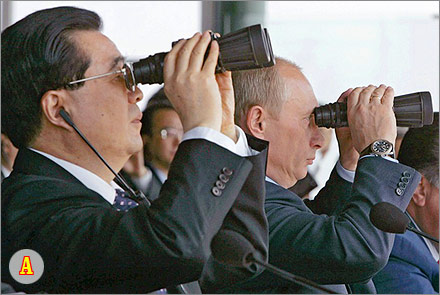

For those contestants keeping track, the presidential cast of the second photo from left to right is Imomali Rakhmon of Tajikistan (nice blue suit), Kurmanbek Bakiyev of Kyrgyzstan, Hu Jintao of China, Vladimir Putin of Russia, Nursultan Nazarbayev of Kazakhstan (nice dictator sunglasses), and Islam Karimov of Uzbekistan.
Are you still sitting there staring at the screen? Get writing! (Or reading, if you don't know what the heck is going on here.)
Please, indicate clearly whether you are submitting a caption for "A" or "B", and limit yourself to only one caption per comment. Remember, this is a humorous (ha ha funny) caption contest, not a space to vent all the frustration with Central Asian politics you've been storing inside for years and have only learned how to release since finding this awesome blog. (Diatribes and manifestos are still welcome on other posts.)
And no, idiot, this obviously isn't the "official" anything contest... so don't ask. The contest ends at the end of August.
For those of you wondering, the "village" in the banner at the top of this entry was occupied by "terrorists" and "liberated" by 5,000 SCO troops (and tanks and fighter jets and paratroopers) during this week's exercise. Looks like a paintball field to me.
posted August 20, 2007 at 12:11 AM unofficial Xinjiang time | Comments (63)
August 16, 2007
Silent Protest
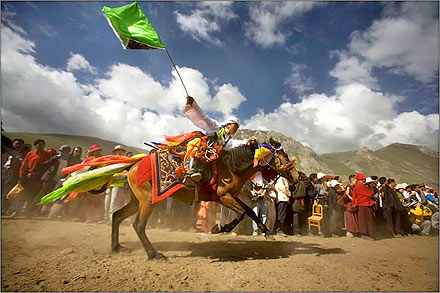
There's an amusing article in today's New York Times about the battle over fur in Tibet. In short, the Dalai Lama' suggestion two years ago that wearing fur is inconsistent with Buddhism has shaped a new battle. On one side, the Chinese authorities are urging people to continue wearing furs as tradition dictates. On the other side, however, most Tibetans are heeding their exiled leader's advice and shunning the traditional festival costume, evening burning their prized furs en masse in some cases.
This perceived act of obedience to a man whom the Chinese government has long vilified as a “splittist,” meaning secessionist, appears to have angered the authorities.
Zhou Hongyuan, deputy governor of Yushu Tibetan Autonomous Prefecture, denied that participants had been ordered to wear animal skins and furs, but he supported the practice. “We are an ethnic region, and we want to create a festive atmosphere and promote our uniqueness,” he said. “It has been our tradition for thousands of years to wear fur.”
Members of Tibetan performance troupes who came here from towns in Qinghai said local officials had urged them to continue wearing their traditional outfits. Judging from the appearance of one group after another, however, the call went almost completely unheeded. During several days of festivities, a visitor was hard pressed to find any conspicuous displays of fur.
I have just one issue with the article to nitpick. Towards the beginning, Howard French describes the audience's cold reaction to the Chinese-speaking M.C.'s:
“Let’s hear a round of applause for your very own Khampa Festival,” shouted the male announcer, drawing little more than murmurs from the audience in this city in western China, just north of the Tibetan border. “One more time, this is your own real and genuine festival,” the man continued gamely, only to be greeted once again by near silence.
He wonders if the audience's response is based on their incomprehension of Mandarin or perhaps their discomfort at the nearby phalanx of security forces. I think neither explanation is probable, because I've seen the same thing happen over and over again at countless public performances around China. A troupe of performers finishes dancing or singing and is met with a wall of silence. A few scattered claps might be heard, but the general response to any performance is indifference. Even at those cheesy acrobatics shows in Beijing, the foreign visitors are almost always the ones pushing the crowd to even minimally react after 88 six year-old girls balance themselves in an inverted pyramid on top of a flaming tricycle.
What's the deal with Chinese crowd reactions, or lack thereof? Give me an "S". Give me a "P". Give me an "I". Give me an "R"... eh, fuck it.
August 16, 2007
Gyegu Journal
Tibetans Turn Festival Into Mute Protest Against China
By HOWARD W. FRENCH
GYEGU, China — With the polish of veteran television M.C.’s, the slick, Chinese-speaking announcers used every trick in the book to try to get a largely Tibetan crowd of a few hundred people involved in the singing and dancing on stage.
“Let’s hear a round of applause for your very own Khampa Festival,” shouted the male announcer, drawing little more than murmurs from the audience in this city in western China, just north of the Tibetan border. “One more time, this is your own real and genuine festival,” the man continued gamely, only to be greeted once again by near silence.
It is possible that in this region of China, where Tibetans cling to their own language, the announcer’s shtick failed for reasons of sheer incomprehension. It could not have helped, though, that the crowd had been corralled by a large deployment of police officers and soldiers who stood by, as if on guard against serious trouble, throughout the morning’s performances.
Then, after a moment of uneasy quiet, the female M.C. offered her own interpretation, heard over a live microphone. “They’re ignoring us,” she said.
This is the season of Tibetan festivals, where people throughout this region gather to celebrate old traditions during the long, hot days of summer, before the early onset of autumn and a harsh, prolonged winter.
The Khampa Festival in Qinghai Province is one of the largest on the calendar and traditionally draws Tibetans from all over western China. This year, for the first time, local officials tried to use the event to promote tourism and development in one of the poorest areas of China. As the muted response to the announcers suggested, however, the event had also acquired a political subtext: the continuing struggle between China and its Tibetan minority over cultural identity and religious freedom.
In recent weeks, China has announced new regulations governing the reincarnation of Tibetan clergy and has acted swiftly against Tibetans at other summer festivals who have hoisted banners with the likeness of their exiled spiritual leader, the Dalai Lama, and in one case, urged people to shout if they wanted the Dalai Lama to be allowed to return from exile.
Most of this province, and parts of several others, including Sichuan and Yunnan, were long part of Tibet itself before China’s People’s Liberation Army marched into the area in 1950 to enforce Beijing’s claim.
With so many security forces on hand in this modest town of about 40,000, nestled in a valley surrounded by high mountains, there was little chance of an outright demonstration in favor of the Dalai Lama. The test of wills played itself out instead around a theme unlikely to have been noticed by many of the tourists from China’s Han majority: whether or not to wear animal fur.
The ceremonial wearing of animal fur has been raised to the status of a political issue in western China, since the Dalai Lama released a statement two years ago urging Tibetans to reject the longtime practice as inconsistent with Buddhism. Reportedly, the Dalai Lama was responding to complaints from Indian conservationists that Tibetans’ fondness for skins from tigers and other endangered species was hastening their disappearance.
As word of the Dalai Lama’s suggestion spread across western China, some Tibetan communities responded by publicly burning their furs, while others simply stopped using furs in ceremonies. This perceived act of obedience to a man whom the Chinese government has long vilified as a “splittist,” meaning secessionist, appears to have angered the authorities.
Zhou Hongyuan, deputy governor of Yushu Tibetan Autonomous Prefecture, denied that participants had been ordered to wear animal skins and furs, but he supported the practice. “We are an ethnic region, and we want to create a festive atmosphere and promote our uniqueness,” he said. “It has been our tradition for thousands of years to wear fur.”
Members of Tibetan performance troupes who came here from towns in Qinghai said local officials had urged them to continue wearing their traditional outfits. Judging from the appearance of one group after another, however, the call went almost completely unheeded. During several days of festivities, a visitor was hard pressed to find any conspicuous displays of fur.
On the eve of their troupe’s performance, a couple of Tibetan dancers from Nangqian County, in Qinghai, practiced twirling moves in their full regalia, including long strands of blue and orange beads that shone in the afternoon sun as they spun.
Asked if he was wearing any animal fur, the man exclaimed, “Absolutely not!” What ensued was a very careful conversation in which the man insisted that wearing fur was against his religion, and then acknowledged receiving “teaching” on the practice two years ago.
Where had the teaching come from? “That’s not convenient to say,” the man’s wife and fellow dancer put in. Asked if their instruction had come from the Dalai Lama, the couple’s faces lit up, and the man reached out to eagerly shake hands. “The government told us we have to wear fur, but we’re not going to do it,” he said. “There are 32 people in our troupe. We’ve agreed that just one of us will wear a small piece.”
The dancers were not alone in their circumspection. With Beijing constantly on guard for anything that smacks of separatism, people here seem to measure their words carefully.
At a monastery perched on a hill high above this town where he receives visitors, Yushu’s holiest Tibetan Buddhist monk, Aenpo Kyabgon, gingerly parried questions about the fur controversy, saying he had avoided the festival altogether.
The monk, who grew up in India and now lives in Australia, was allowed to enter the country recently with a warning against engaging in politics.
“I don’t believe in saying you must or mustn’t do something,” he said elliptically. “These things depend upon the individual. But from the Buddhist spiritual point of view, we definitely have to refrain from certain things, such as violence in killing animals.”
posted August 16, 2007 at 01:33 PM unofficial Xinjiang time | Comments (67)
August 15, 2007
Sundried Tomatoes on the Silk Road
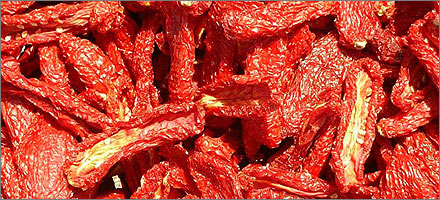
Sure, this is a shameless use of this blog for search engine optimization purposes, but can you blame me?
After all, when I'm not munching on naan or rockin' to the latest Uyghur VCD, I can often be found supervising the hard-working collective farmers who cut and dry China's finest sundried tomatoes. August is tomato season, so it's high time I put this blog to work.
Sundried tomatoes from China, you ask? Yes, you heard right. And these sundried tomatoes aren't produced using just some ho-hum common variety of tomato, but with extremely high quality tomatoes from Xinjiang.
So when you and your buddies are sippin' brew and chatting about Chinese sundried tomatoes, don't look like a fool. Just tell 'em about Demay Foods. Tell 'em Michael sent you. Tell 'em that their search is over.
posted August 15, 2007 at 04:44 PM unofficial Xinjiang time | Comments (58)
August 07, 2007
An Arrow in the Buttocks of Terrorism
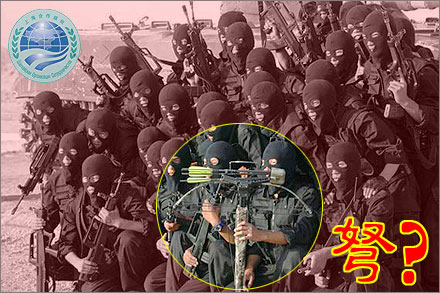
Check out the photo above of Chinese special forces soldiers assembled for the coyly named "Peace Mission 2007", which begins on Thursday in Urumqi and will quickly move west to the Ural Mountains in Russia. SCO member states have been very clear about the focus of this 6-nation military exercise:
"The joint drill will not indulge in empty talk but practice coordination and command in anti-terror combat. It will also serve to maintain regional peace and stability," Zhen said, noting that it is hard for one country or its military forces to crack down on all terrorist organizations and activities that continue to grow worldwide....
"We can only cope with security challenges, and secure peace and development by enhancing cooperation when terrorism, separatism and extremism are active in the region," Qian said.
As you can see clearly, China's show of force includes not only tanks, fighter jets, and helicopters but also bad-ass ski mask-wearing commandos equipped with carbon fiber composite crossbows. They can't wait for the moment when a deer ― splittist Rebiya Kadeer, that is ― wanders unsuspectingly into a clearing in the woods. Thwack! One down, nine million to go.
It's not exactly clear what group of "special forces" is shown in the photo above, but there was a possible clue in Saturday's South China Morning Post:
A rather secretive branch of the People's Liberation Army has been expanding, despite a general trend of downsizing in the army, to cope with growing social unrest on the mainland. The People's Armed Police was set up in 1983 to maintain internal security....
Official figures on the size of the paramilitary force, like a lot of other military data, are top secret, but there are varying estimates, with some saying up to 1 million....
"Unlike police officers who are taught to comply with the law, the armed police are trained to combat problems with violence and speed," he said.
On top of the expansion in personnel, the force's weapons have also been upgraded. Mr Wong said armed police officers were now equipped with more specialised weapons. "There are some weapons that will keep someone under control without harming them. This has become an issue, especially since the crackdown on students in... 1989," he said.
In 2003, Mei Xingrun , the armed police's commander in Xinjiang , where a Muslim separatist movement has been a thorn in the government's side, told Xinhua that military spending had been increased to crush the "terrorists" in the region.
So I guess that explains the crossbow. An arrow in the buttocks is certainly more pleasant, and less lethal, say, than a bullet in the head. Who says the Chinese government doesn't look out for the welfare of the downtrodden and disenfranchised?
The articles are available below.
SCO joint drill to improve anti-terror capability: experts
6 August 2007
Xinhua News Agency
CHELYABINSK, Russia, Aug. 6 (Xinhua) -- A joint anti-terrorism military exercise, sponsored by the Shanghai Cooperation Organization (SCO) and slated for Aug. 9-17, will enhance the exchange among SCO member countries and improve their counter-terror capabilities, experts said.
"In terms of both scale and content, the joint drill will reflect the trends of counter-terror exercises and bears an historic significance as a milestone in military cooperation between the six SCO member countries," said Zhen Shouhua, a researcher with the Chinese Academy of Military Science.
The "Peace Mission 2007" drill, involving about 6,500 military personnel from China, Kazakhstan, Kyrgyzstan, Russia, Tajikistan and Uzbekistan, will be carried out in the Ural Mountains city of Chelyabinsk and Urumqi, capital of China's Xinjiang Uygur Autonomous Region.
Commanders from the six countries will hold consultations and make decisions in Urumqi upon receiving alert of an assumed terrorist attack on a Russian town and the field practice will then continue in Russian military ranges near Chelyabinsk.
"The joint drill will not indulge in empty talk but practice coordination and command in anti-terror combat. It will also serve to maintain regional peace and stability," Zhen said, noting that it is hard for one country or its military forces to crack down on all terrorist organizations and activities that continue to grow worldwide.
Heads of states and defense ministers of the SCO member countries will attend the live fire exercise on Aug. 17, which will involve airborne troops, special task forces, armored vehicles, military helicopters and fighters, said Qian Lihua, deputy general director of the Chinese troops.
Such drill has been expanded with increasing member countries, combined troops and a much more complicated situation since the first of its kind was held in 2002, Qian said.
"We can only cope with security challenges, and secure peace and development by enhancing cooperation when terrorism, separatism and extremism are active in the region," Qian said.
Secretive arm of the law
4 August 2007
South China Morning Post
A rather secretive branch of the People's Liberation Army has been expanding, despite a general trend of downsizing in the army, to cope with growing social unrest on the mainland.
The People's Armed Police was set up in 1983 to maintain internal security.
It is administered by both the State Council through the Ministry of Public Security and the PLA's Central Military Commission.
Official figures on the size of the paramilitary force, like a lot of other military data, are top secret, but there are varying estimates, with some saying up to 1 million.
Antony Wong Dong, president of the International Military Association in Macau, said western military experts put the number at somewhere between 200,000 and 300,000 personnel.
A substantial number of new recruits to the force were among those trimmed from the PLA, Mr Wong added.
"This force is something between the police and the army. Their combat ability is superb and better than the police, given their military background," he said.
Some observers have said that the armed police are expanding their ranks during a period of frequent demonstrations, riots and disputes spawned by rampant corruption and social injustice which, in turn, are the result of the government's blind pursuit of economic growth.
In one of the worst recent flare-ups, armed police shot dead at least three villagers involved in land dispute protests in Shanwei , Guangdong, on December 6, 2005.
Mr Wong said that with their military background, armed police had gained notoriety over the years for their tendency to resort to violence more often than other disciplinary forces.
"Unlike police officers who are taught to comply with the law, the armed police are trained to combat problems with violence and speed," he said.
On top of the expansion in personnel, the force's weapons have also been upgraded. Mr Wong said armed police officers were now equipped with more specialised weapons.
"There are some weapons that will keep someone under control without harming them. This has become an issue, especially since the crackdown on students in Tiananmen in 1989," he said.
The force has also acquired new duties throughout the years, one of them being a counterterrorism mission.
Those duties have gained more importance since the September 11 terrorist attacks in the United States.
In 2003, Mei Xingrun , the armed police's commander in Xinjiang , where a Muslim separatist movement has been a thorn in the government's side, told Xinhua that military spending had been increased to crush the "terrorists" in the region.
With the 2008 Beijing Olympics looming closer, the armed police, together with the police, will be responsible for ensuring the Games go smoothly.
The government has vowed to send 3,000 armed police officers to patrol every day when Beijing launches a rehearsal of the Games this month.
According to Mr Wong, units are also trained to prepare for any possible conflict with Taiwan.
Other responsibilities include guarding forests, gold mines, hydroelectric power infrastructure and transport.
Kristine Kwok
posted August 07, 2007 at 08:54 AM unofficial Xinjiang time | Comments (44)
August 03, 2007
Tire Fire Haiku
A tire fire
burns brightly in Xinjiang
I took photographs.


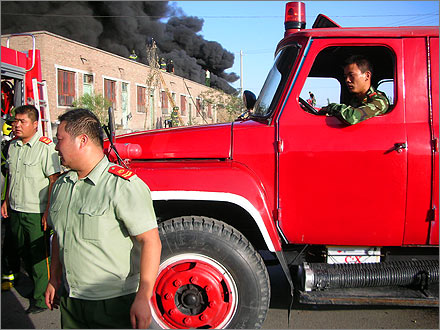
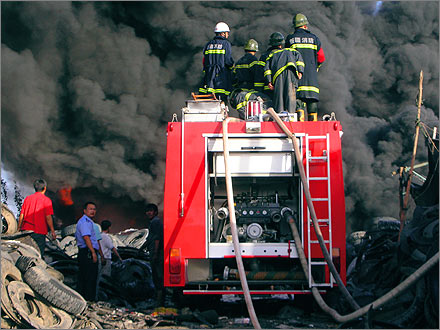
Ah, a burning pile of tires. Now that's entertainment... in Korla. (Notice the train passing directly through the flames on the rail line behind the fire.) Bring on the toxic fumes!
posted August 03, 2007 at 12:01 PM unofficial Xinjiang time | Comments (72)
August 02, 2007
I May Have Already Won.
In fact, I have won the 2007 China Blog Awards, err... award, for Best News Blog. You can see how I've craftily altered the graphic in the sidebar on the left to reflect my winning status. Thanks to all of you who voted (201 of you pushed this site to the top) and to Chinalyst for finally pulling off a successful China blog contest. I'm going to fake Disneyland!
posted August 02, 2007 at 11:52 PM unofficial Xinjiang time | Comments (32)
